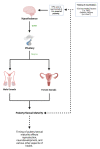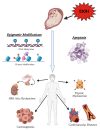Toxic and Teratogenic Effects of Prenatal Alcohol Exposure on Fetal Development, Adolescence, and Adulthood
- PMID: 34445488
- PMCID: PMC8395909
- DOI: 10.3390/ijms22168785
Toxic and Teratogenic Effects of Prenatal Alcohol Exposure on Fetal Development, Adolescence, and Adulthood
Abstract
Prenatal alcohol exposure (PAE) can have immediate and long-lasting toxic and teratogenic effects on an individual's development and health. As a toxicant, alcohol can lead to a variety of physical and neurological anomalies in the fetus that can lead to behavioral and other impairments which may last a lifetime. Recent studies have focused on identifying mechanisms that mediate the immediate teratogenic effects of alcohol on fetal development and mechanisms that facilitate the persistent toxic effects of alcohol on health and predisposition to disease later in life. This review focuses on the contribution of epigenetic modifications and intercellular transporters like extracellular vesicles to the toxicity of PAE and to immediate and long-term consequences on an individual's health and risk of disease.
Keywords: alcohol; developmental origin of health and disease; early childhood adversity; epigenetic modification; extracellular vesicles; miRNA; prenatal alcohol exposure.
Conflict of interest statement
The authors declare no conflict of interest.
Figures



References
-
- Lipinski R.J., Hammond P., O’Leary-Moore S.K., Ament J.J., Pecevich S.J., Jiang Y., Budin F., Parnell S.E., Suttie M., Godin E.A., et al. Ethanol-Induced Face-Brain Dysmorphology Patterns Are Correlative and Exposure-Stage Dependent. PLoS ONE. 2012;7:e43067. doi: 10.1371/journal.pone.0043067. - DOI - PMC - PubMed
Publication types
MeSH terms
Substances
Grants and funding
LinkOut - more resources
Full Text Sources
Medical
Research Materials

